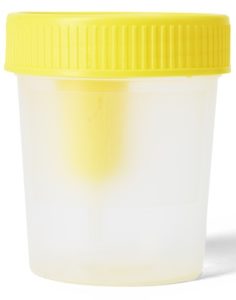Electrolytes on Dialysate
Electrolytes on Dialysate - DOWNLOAD
Electrolyte testing on dialysate includes Sodium, Potassium, Bicarbonate, Magnesium and Calcium.
- Using sterile technique, collect specimen from the dialysate source using a Sterile Cup with Transfer Port (Yellow) and 1 White Top Tube.


- Remove the Cup’s lid. Place the lid on the counter facing upward.
- Turn on the dialysate and allow it to run for a minimum of 15-30 seconds. The purpose of this flush is to remove all residual material that may interfere with electrical potential readings.
- While the dialysate is running, collect a midstream clean catch, filling the Cup 3/4 full. Turn off the dialysate and secure the lid.
- Peel back the protective sticker on the Cup’s lid to expose the transfer port.
- Insert the top of the White Top Tube into the transfer port. This will pierce the stopper and allow the tube to fill automatically. Allow the tube to fill until the flow ceases.

- Discard the Cup after use. Do not send to the laboratory.
- Use the bar code label to identify the specimen.
- Place the labeled tubes in a plastic Transport Bag with an absorbent sheet and seal shut.
- Refrigerate at 2°-8° C.
- Due to short stability, specimens must be collected and shipped to the laboratory Monday through Friday only.
